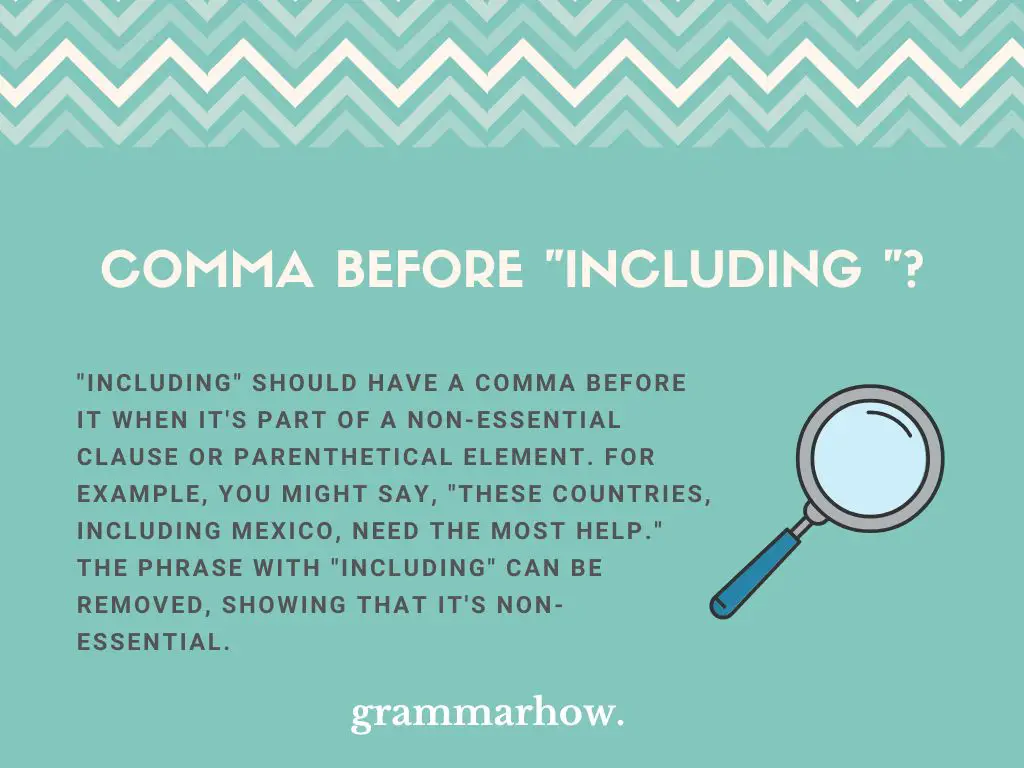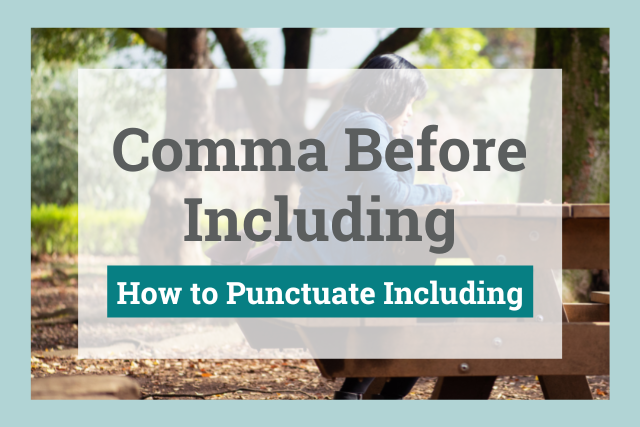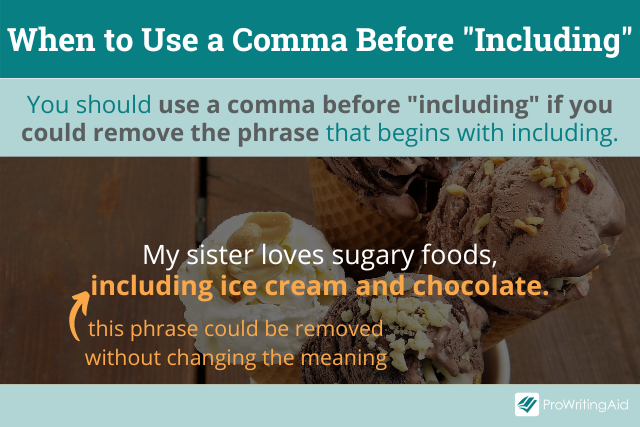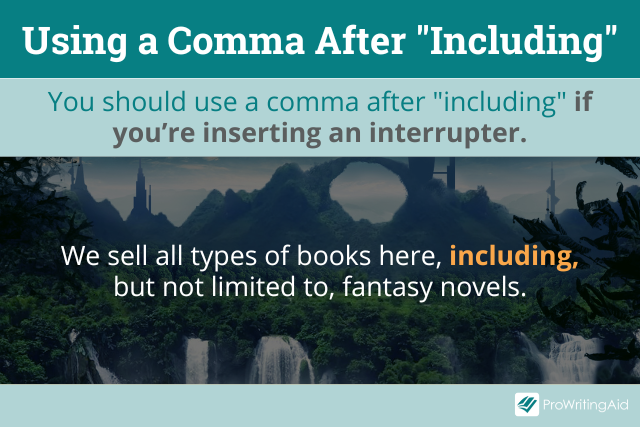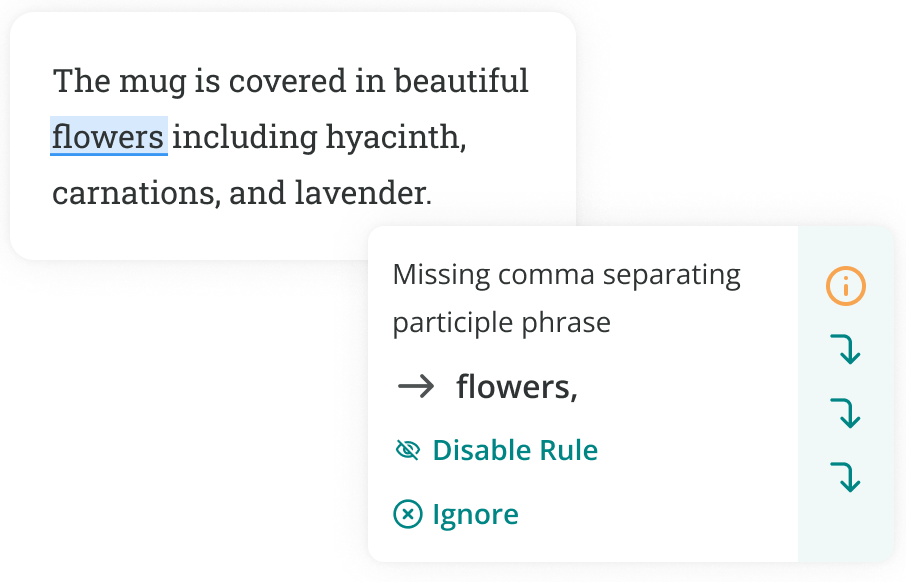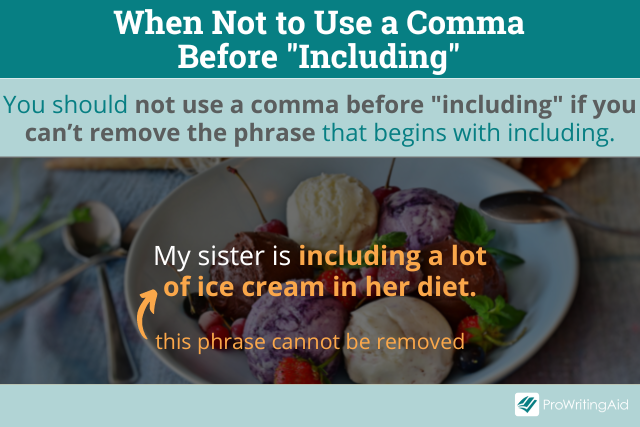“Including” is a surprisingly difficult word to punctuate correctly. It’s a preposition and a verb, depending on how you use it. This can lead to difficulty understanding the comma rules. This article will explore all you need to know when punctuating “including.”
“Including” should have a comma before it when it’s part of a non-essential clause or parenthetical element. For example, you might say, “these countries, including Mexico, need the most help.” The phrase with “including” can be removed, showing that it’s non-essential.
KEY TAKEAWAYS
- “Including” rarely requires a comma.
- You should only include a comma before “including” when it is the first word of a non-essential clause, e.g. “this, including that, is correct.”
Here are a few more examples to demonstrate how this works:
- Matt’s friends, including Billy, decided playing a few pranks on him would be fun.
- The cities, including Chicago, all elected to vote on the new protocols.
“Including” is part of a non-essential phrase in both examples. You may remove it, and the sentence will still make sense. For example:
- Matt’s friends decided playing a few pranks on him would be fun.
This is the most likely time when a comma comes before “including.”
The Chicago Manual of Style and the AP Stylebook both explain that commas are treated like parentheses. This means you may use them to include additional information in a sentence. You do not have to include the information (and it can be removed).
When to Place a Comma Before “Including”
There aren’t many situations where commas work with “including.” Once you know the main situations, you’ll know all of them.
A comma comes before “including” when it is the first word of a non-essential clause. The easiest way to test whether a clause is non-essential is by removing it from a sentence.
- The people, including my mother and father, were going to watch.
- The people were going to watch.
Here, you can see that “including” is non-essential to the sentence. A comma comes before it to offset the non-essential clause before going into more detail.
When to Use “Including” Without a Comma
“Including” is most commonly seen without a comma. It is a verb in most cases, meaning you do not need to use a comma because it demonstrates the action of “including” something.
In most sentences, “including” is an action. You can use it in the following ways without punctuation:
- I wrote those including but not limited to the rest of the products as well.
- We were including everybody in our games, but we don’t want to do that anymore.
- Including Jackie was a mistake. We’re so sorry we put you through that.
You might also find that “including” is part of a restrictive clause. This is similar to a non-essential clause because it’s not a complete sentence. However, it does not get any commas around it because it “restricts” the rest of the sentence from being correct on its own.
Here’s what a restrictive clause with “including” looks like:
- I only eat meals including burgers.
Here, “including burgers” is used to show that you only eat specific types of meals. You do not need a comma before “including” because it is not a non-essential clause. If you remove “including burgers,” the sentence makes very little sense.
- I only eat meals.
This is the easiest test to see whether “including” is non-essential or restrictive. Remove the phrase starting at “including” to find out whether a comma is needed.
Comma After “Including”?
There is never a time when a comma should come after “including.” “Including” comes with two main uses: a preposition or a verb. Neither situation requires a comma after it because “including” is supposed to continue into more information.
You may not include a comma after “including” before a list, even though some people have a habit of doing this:
- Correct: The singers, including Miley Cyrus and Billie Eilish, were all there.
- Incorrect: My friends, including, Matt, Joseph, and Clark, knew I was going to be with them.
Including a comma after “including” makes no sense here. You should avoid doing it because it creates a jarring pause in the sentence structure.
Martin holds a Master’s degree in Finance and International Business. He has six years of experience in professional communication with clients, executives, and colleagues. Furthermore, he has teaching experience from Aarhus University. Martin has been featured as an expert in communication and teaching on Forbes and Shopify. Read more about Martin here.
Use a comma before “including” and “such as” when followed by a nonrestrictive, nonessential phrase or clause. The new policy applies to everyone, including faculty.
Contents
- 1 How do you put including in a sentence?
- 2 What punctuation to put after include?
- 3 Do you use a colon after the word including?
- 4 How do you punctuate including but not limited to?
- 5 How do you use including?
- 6 How do you write a list with including?
- 7 How do you use a comma with including?
- 8 Do you put comma after include?
- 9 Does including mean in addition to?
- 10 What does it mean to say including but not limited to?
- 11 Which include or include?
- 12 Where do you put semicolons?
- 13 Is as follows grammatically correct?
- 14 Can a sentence start with including?
- 15 WHAT IS THE including sentence in the paragraph?
- 16 What is mean of include?
- 17 How do you use include before a list?
- 18 How do you structure a list in a sentence?
- 19 Do you add a comma before Such as?
- 20 What are the 8 rules for commas?
How do you put including in a sentence?
Including sentence example
- Was he including himself in that statement?
- Dean gave Winston the information, including both names, Cleary and Corbin.
- About twenty people were present, including Dolokhov and Denisov.
- The smile broadened, including the dimple.
- He was wearing a hoodie and dressed in black, including gloves.
What punctuation to put after include?
Other tips. A few other points about ‘such as’ and ‘including’: Do not use a colon (:) after one of these terms; they are meant to directly introduce the relevant examples. It is acceptable to use a colon following a phrase such as “including the following:” at the end of a complete statement (independent clause).
Do you use a colon after the word including?
Do not use a colon in a complete sentence after phrases such as “such as,” “including,” and “for example.” Because phrases like these already indicate to the reader that a list of examples will follow, there is no need to introduce them with a colon, which would merely be redundant.
How do you punctuate including but not limited to?
Therefore “including but not limited to” is redundant (unless you are a lawyer writing a contract). Just use “including.” Comma use is subjective and in most, but not all cases is a style choice. The only place in that sentence where commas are required is in the list at the end (running, jumping, and swimming).
How do you use including?
You use including to introduce examples of people or things that are part of the group of people or things that you are talking about. Thousands were killed, including many women and children.
How do you write a list with including?
“I met so many interesting people, including a writer, a photographer, and an aviator.” Words like “including” or “such as” are often used to introduce examples that further explain something mentioned in the sentence. They suggest that you are going to list just a few of the relevant items.
How do you use a comma with including?
Use a comma before “including” and “such as” when followed by a nonrestrictive, nonessential phrase or clause. The new policy applies to everyone, including faculty. Some students make silly excuses, such as “My dog ate my homework.”
Do you put comma after include?
2. Use commas after introductory a) clauses, b) phrases, or c) words that come before the main clause. a. Common starter words for introductory clauses that should be followed by a comma include after, although, as, because, if, since, when, while.
Does including mean in addition to?
include Add to list Share. The verb include means to consider as a part of something. A list of your favorite things may include chocolate and friends. The verb include also means adding something (or someone) to a category or group.
What does it mean to say including but not limited to?
What’s the origin of the phrase ‘Including, but not limited to’? The expression “including, but not limited to” arose and is usually used in legal or other official contexts.In essence the phrase is used to mean “including ‘these important things’, but also including ‘all the other things I can’t think of right now’.
Which include or include?
The answer is including. When you want to mention something which is included in the thing you are talking and use “include” to lead the thing(s), then you use “including”. if you want to say the same thing but use “include” to end the sentence, then you use “included”.
Where do you put semicolons?
Using Semicolons
- A semicolon is most commonly used to link (in a single sentence) two independent clauses that are closely related in thought.
- Use a semicolon between two independent clauses that are connected by conjunctive adverbs or transitional phrases.
Is as follows grammatically correct?
‘As follows’ is correct, not ‘as follow. ‘ ‘As follows’ is used for both singular and plural situations.
Can a sentence start with including?
You can: Including him would be a huge mistake. This is a sentence fragment and should be separated from the previous sentence using a comma or, possibly (very much case-dependent) a semicolon. The following list should also be separated from the clause using a colon, and I’d watch your comma usage.
WHAT IS THE including sentence in the paragraph?
The most important sentence in your paragraph is the topic sentence, which clearly states the subject of the whole paragraph. The topic sentence is usually the first sentence of the paragraph because it gives an overview of the sentences to follow.
What is mean of include?
include, comprehend, embrace, involve mean to contain within as part of the whole. include suggests the containment of something as a constituent, component, or subordinate part of a larger whole. the price of dinner includes dessert comprehend implies that something comes within the scope of a statement or definition.
How do you use include before a list?
The definition of the verb “to include” is not the same as the definition of the verb “to be.” By definition, if we use the word include or including before a list, we are telling the reader that the list is not exhaustive.
How do you structure a list in a sentence?
In-sentence lists
- Use a colon to introduce the list items only if a complete sentence precedes the list.
- Use both opening and closing parentheses on the list item numbers or letters: (a) item, (b) item, etc.
- Use either regular Arabic numbers or lowercase letters within the parentheses, but use them consistently.
Do you add a comma before Such as?
Use such as to provide specific examples of something you’re talking about. If the specific examples aren’t essential to the accuracy of your sentence, then use a comma before such as and after your example, unless the example is at the very end of the sentence.
What are the 8 rules for commas?
Commas (Eight Basic Uses)
- Use a comma to separate independent clauses.
- Use a comma after an introductory clause or phrase.
- Use a comma between all items in a series.
- Use commas to set off nonrestrictive clauses.
- Use a comma to set off appositives.
- Use a comma to indicate direct address.
- Use commas to set off direct quotations.
Commas separate information, and when you use words like including in your sentences, you infer a separation or continuation of ideas.
Does that mean you also need to use a comma before the word including?
Where you add or leave out a comma changes the meaning of sentences, and knowing their proper placement is the difference between your reader understanding your writing – or being confused. Let’s look at where to place a comma when the sentence also includes the word including.
Why Use the Word Including in a Sentence?
According to the Oxford Language Dictionary, the word including is a preposition to mean “containing as part of a whole.”
A preposition is a noun that usually precedes a noun or pronoun to express a relationship to another element in the sentence. When used, it provides readers with additional information, examples, or details of a main topic or subject.
This is helpful for a reader to have an understanding of your message. This is especially important when writing for content, such as on a resume (by the way, the same rules in this article apply to the phrase “such as”).
For example:
- On Wednesday, there is going to be an SAT review including practice sessions and past tests, so students know what to expect.
Basic Comma Rules
Commas play many roles in sentence organization, but one of their main uses is to separate information.
This rule is important. When you see a comma used, you know that the information following its placement is separate (albeit related) to the phrase or clause that preceded it.
For example:
- We weren’t convinced there would be rain, and I made sure to watch the radar to avoid prematurely canceling the event.
In this sentence, the comma separates two independent clauses connected by a coordinating conjunction (and). Its placement highlights two different complete thoughts: 1) the lack of conviction concerning a rain storm and 2) watching the radar to avoid the cancellation of an event.
If the coordinating conjunction was removed, both clauses would still be complete sentences.
Let’s look at another example where a comma is not used:
- We weren’t convinced it would rain and watched the radar to avoid the premature cancellation of the event.
The information following the coordinating conjunction (and) is dependent upon the independent clause that precedes it. It is not a complete sentence and could not be a stand-alone idea.
If that information was removed from the sentence, the entire meaning would change from a lack of conviction that led to watching the radar to only being about not being convinced of rain.
When Should You Use a Comma With the Word Including?
Now, let’s combine what we know about the preposition “including” and comma use to determine when we need a comma and when we don’t.
We’ll start with a simple example:
- I like cookies including chocolate.
- I like cookies, including chocolate.
What’s the difference between these two sentences? Do you know?
Let me give you a hint: the placement of the comma changes the meaning of the word including.
In the first sentence, the lack of a comma indicates that I like cookies that include chocolate in them. In the second sentence, the comma indicates that I like all cookies, including chocolate cookies.
See the difference now?
Let’s try another example:
- I gathered materials from various resources including curriculum building and basic skill assessments.
This sentence indicates that I gathered various resource materials that contain curriculum building and basic skill assessments.
- I gathered materials from various resources, including curriculum building and basic skill assessments.
This sentence indicates that I gathered materials from various resources, some of which were about curriculum building and some about basic skill assessment.
Let’s Review
When you use the word including in your writing, you provide your reader with more detail and understanding of a central message. However, the placement of a comma can change everything.
Make sure you understand when to use a comma and when not to. Its use can change the overall meaning of your sentence, which could confuse your reader.
Many people get confused about how to punctuate the word including in a sentence. If you’re wondering what punctuation to use, you’re not alone.
So when do you need to use a comma before a word like including?
You should use a comma before including when you’re adding a nonessential clause or phrase, which doesn’t change the basic meaning of the sentence.
If the phrase beginning with including is essential for the meaning of the sentence, you shouldn’t use a comma.
In this article, we explain these grammatical rules and give you examples of sentences that do and do not use a comma before the word including.
Should You Put a Comma Before or After Including?
To decide whether or not you need to use a comma before including, imagine what would happen if you were to remove the phrase that begins with including. How much would that change the meaning of the sentence?
If taking out the phrase that begins with including would alter the fundamental meaning of the sentence, you should not use a comma before including.
This is because you don’t want to separate that phrase from the rest of the sentence.
On the other hand, if taking out the phrase wouldn’t fundamentally alter the meaning, you should use a comma before including.
Let’s look at each of these situations in more detail.
Comma Before Including
You should use a comma before including if you’re using the word including to introduce a non-restrictive clause or phrase.
In other words, you should use a comma if you could remove the phrase that begins with including without completely changing the sentence.
For example, consider the sentence, “My sister loves sugary foods, including ice cream and chocolate.”
You can take out the phrase, “including ice cream and chocolate” without changing the fundamental meaning of the sentence.
The sentence, “My sister loves sugary foods.” can stand alone to express what you’re trying to say.
Here are some other examples of cases when you need to use a comma before including:
- She’s met many influential people, including the President of the United States.
- I’ve watched all the Tom Cruise movies, including Mission Impossible and Top Gun.
- You need to complete all your homework assignments, including the boring ones.
Comma After Including
Using a comma after including is much rarer than using a comma before including.
You should only do this when you’re interrupting the sentence with another word or clause immediately after the word including.
For example, consider the sentence: “We sell all types of books here, including, but not limited to, fantasy novels.”
The purpose of the comma after including is to add a pause before the interrupter “but not limited to.”
Here are some other examples of cases when you might use a comma after including:
- I love eating weird foods, including, on occasion, rattlesnake meat.
- We need to write lots of thank-you cards, including, as you know, one to Grandma.
- Bobby has many health conditions, including, as his mother mentioned, severe asthma.
If you’re not sure whether to include a comma before or after including, you can run your writing through ProWritingAid, which will highlight incorrect comma usage and help you fix it.
No Comma Before or After Including
On the other hand, you should not use a comma before including if you’re using including to introduce a restrictive phrase or clause.
In other words, you shouldn’t use a comma if removing the phrase that begins with including would fundamentally change the meaning.
For example, consider the sentence, “My sister is including ice cream in her diet.”
In this case, taking out the phrase “including ice cream in her diet” would change the meaning of the sentence because, “My sister is” doesn’t express a complete thought.
Here are some other examples of cases when you don’t need to use a comma before including:
- I’ll be including some of your photos in my portfolio.
- Are we including Sarah on the guest list?
- You only laugh at movies including slapstick humor.
Should You Put a Semicolon Before Including?
You should never use a semicolon before including. Semicolons should primarily be used to separate items on a list or to separate two complete thoughts.
The word including is rarely used to start a complete thought, so you should use a comma before this word, not a semicolon.
Examples Using Including in a Sentence
Let’s look at some examples from English literature of sentences that use or omit a comma before the word including.
“By including animals in my life I was always engaging with the Other, imagining the animal mind and life.”—Brenda Peterson, Build Me an Ark
“I saw him glance at Amena, who at the moment was an inert pile of limbs under a blanket with a pillow jammed into her face. (Humans do everything weird, including rest.)”—Martha Wells, Network Effect
“Most things break, including hearts. The lessons of life amount not to wisdom, but to scar tissue and callus.”—Wallace Stegner, The Spectator Bird
“As strong as he looked, inside he was a ruin, or perhaps a funeral pyre, like the Cusp—only instead of the melted bones of ijji, he was made up of the skeletons of babies and children, including, as he had always believed, his own child: her.”—Laini Taylor, Strange the Dreamer
“When it comes to actually pulling this off, the writer is much more fortunate than the filmmaker, who is almost always doomed to show too much…including, in nine cases out of ten, the zipper running up the monster’s back.”—Stephen King, On Writing
Conclusion on How to Punctuate Including
There you have it: a complete guide for how to punctuate including. Here’s a quick recap:
- Use a comma before including when you’re introducing a nonessential phrase.
- Don’t use a comma before including when you’re introducing an essential phrase.
- Use a comma after including when you’re adding an interrupter.
ProWritingAid can help improve all types of writing, including yours!
Take your writing to the next level:
20 Editing Tips From Professional Writers
Whether you are writing a novel, essay, article, or email, good writing is an essential part of communicating your ideas.
This guide contains the 20 most important writing tips and techniques from a wide range of professional writers.

This is one of the point that I too have a problem with. What I feel is that
Oxford Advanced Learner’s Dictionary gives defines «including» as «having something as part of a group or set» and gives the following examples:
1. I’ve got three days’ holiday including New Year’s Day.
2. Six people were killed in the riot, including a policeman.
There is one more in the same page under «Usage notes»:
3. The website has a variety of interactive exercises, including matching games, crosswords and quizzes.
But whenever I encounter the word «including» I tend to insert the comma. The reason is that the words/phrases that the word «including» is some additional information/an important information that affects the flow of the sentence and also that the words that the word «including» introduces are not an all-inclusive list (as in the above examples; though «1» does not carry a comma, for which I’m finding the answer for).
But see the below sentence:
The G8 countries including France , Germany , Italy , Japan , the United Kingdom , the United States , Canada, and Russia participated in the G8 summit held at New Delhi.
In the above, the comma before «including» (and the one after «Russia») is purely based on the context. If the writer feels that the intended audience of this sentence do not know about the members of G8 countries, he can make it defining by not inserting the comma before «including». If he feels, the readers know he can set of the phrase within commas. Please note here the word including introduces a all-inclusive list.
Awaiting further discussion on this and also the reason why the comma is not used in the first example!!!

